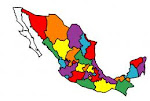 We left the motorhome in San Miguel de Allende and drove the car for two hours to the Colonial silver mining town of Guanajuato where we stayed two nights in a hotel right on the Jardine Union or Central Square. The town is built on opposing banks of the river that used to flow through the town. After dealing with repeated flooding of the river, the residents finally diverted the river altogether. The old riverbeds now provide the routes for the many covered tunnels that move traffic through the city. Guanajuato is situated 2,008 m or 6,586 feet above sea level and everywhere you go requires walking uphill to get there and downhill to come back. Between the altitude, the hills, Norma with her barely healed hip and me with my old ankle injury, I was very surprised that we could cover as much of the town as we did. There is absolutely no parking downtown so we just found a parking lot and left the car there. The main downtown streets are closed to traffic so cabs are not an option either. “Hoofing It” is the only way around and we did a ton of that over our two days! The town has many great little restaurants and places to sit and people watch. It does not however have many English speaking residents so a command of at least a little Spanish is very helpful if not essential!
We left the motorhome in San Miguel de Allende and drove the car for two hours to the Colonial silver mining town of Guanajuato where we stayed two nights in a hotel right on the Jardine Union or Central Square. The town is built on opposing banks of the river that used to flow through the town. After dealing with repeated flooding of the river, the residents finally diverted the river altogether. The old riverbeds now provide the routes for the many covered tunnels that move traffic through the city. Guanajuato is situated 2,008 m or 6,586 feet above sea level and everywhere you go requires walking uphill to get there and downhill to come back. Between the altitude, the hills, Norma with her barely healed hip and me with my old ankle injury, I was very surprised that we could cover as much of the town as we did. There is absolutely no parking downtown so we just found a parking lot and left the car there. The main downtown streets are closed to traffic so cabs are not an option either. “Hoofing It” is the only way around and we did a ton of that over our two days! The town has many great little restaurants and places to sit and people watch. It does not however have many English speaking residents so a command of at least a little Spanish is very helpful if not essential!Guanajuato and its surrounding area was the jewel in the Spanish occupiers crown in the early Seventeenth Century. It produced 35% of the world’s silver at the time and was the source of great wealth for both the occupying forces and for Spain itself. The Spaniards treated the local population as disposable slaves to mine the silver. This was the situation in 1810 when Hidalgo, Allende, Aldama and Jimenez set off from nearby Dolores Hidalgo with a small initial force of 700 peasants and workers. As they traveled south to San Miguel and then west to Guanajuato this force grew to over 20,000 as more people lay down their tools, picked up pitchforks, machetes and other makeshift weapons and joined the ragtag army of the Movement for Independence.
As they approached Guanajuato the Spanish occupiers retreated into a massive grain storage building called the Alhondiga de Granaditas. Hidalgo’s forces had no artillery so the Spaniards might have been safe in their stronghold but for the act of a brave young miner called El Pipila. I have told the story before but El Pipila (Jose de los Reyes Martinez) tied a slab of stone to his back to protect himself from the Spanish bullets raining down on him and set fire to the massive wooden doors of the stronghold, allowing the rebel forces to storm in and kill the occupiers. There is a huge monument to El Pipila overlooking the town he was so instrumental in freeing. It is accessible by an incline railway or “Funicular” and is a great place to look over and photograph the city. At his feet on the Monument is the inscription, “AUN HAY OTRAS ALHONDIGAS POR INCENDIAR” (There still remains other Alhondigas to burn).
The Alhondiga de Granaditas became a Federal prison for almost a Century but has now become a museum to the War of Independence. When Hidalgo, Allende, Aldama and Jimenez, the leaders of the rebellion were captured and executed, their severed heads were hung from the four corners of the Alhongida in an unsuccessful attempt to frighten and intimidate the citizens. It had the opposite effect and served only to enrage the population and lead to the eventual expulsion of the Spanish Occupiers.







These are great pictures. Thank you for the journey!
ReplyDeleteCroft, you should become a travel writer. Darn fine reporting and coverage of the journey.
ReplyDeleteMuchos gracias!